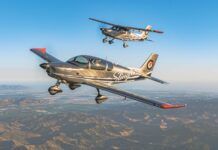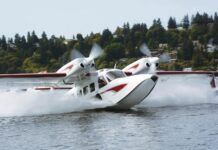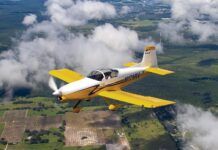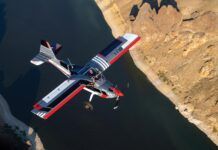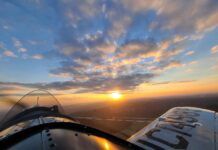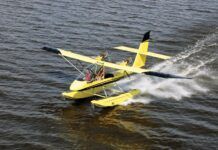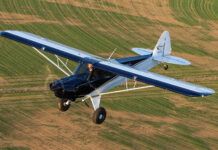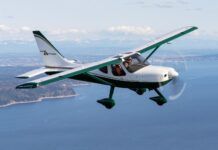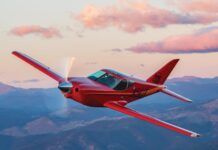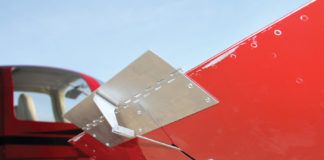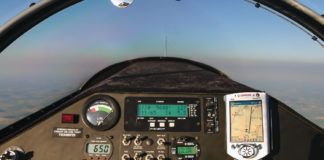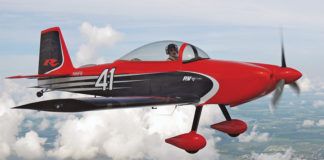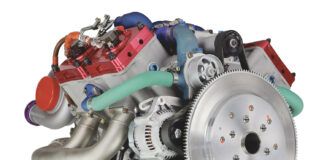Fred Galloway is a bricklayer not a financial genius. But to those who know him around the Santa Ynez (California) airport, his airplane-building skills and, more to the point, his fiscal self control are revered. The airplane you see here, a straight-down-the-line Vans RV-9A, was completed in late 2007 from a kit for mind bogglingly little money. Pocket change. A tidy sum that represents the down payment on a kit or the engine alone for many “mainstream” kitbuilt projects. Builders have spent more on the construction of instrument panels-less the instruments. In the words of Maxwell Smart, would you believe $30,000?
First, some disclosure. The airplane you see here was brought to this point for very close to $30,000, maybe a smidge over, concedes the builder. Its not IFR equipped, its not painted, and its not well and truly done. (Then again, when are these things ever?) It is simple and, without intending to sound unkind, it is austere.
It is, however, precisely what Galloway wanted.
Not Far From the Pack
In many respects, there’s little to distinguish his RV-9A from the 364 others that have flown as of early February 2008. You wont find Ace Hardware bolts in the mainspar. You wont find utility cart tires or minibike band brakes on the wheels. The engine is a used Lycoming O-320 that was once on another RV and had been converted with the usual higher-compression pistons that bump power to 160 horsepower-not a strip-and-paint junker. Even so, Galloway dismantled and inspected the engine, rebuilding it with new consumables; in the end it cost him much less than half of what a new O-320 would. (And, at that, the O-320 tends to be undervalued compared to the O-360, though that delta is narrowing.) Galloways Lycoming swings a fixed-pitch Sensenich prop, bought new from Vans.
Partners in Parsimony
Were getting a bit ahead of the story. Galloways name might be familiar if you recall the story we did in 2006 on Stan Peternels gorgeous and extremely well equipped RV-9A. The two were building partners at the time.
Galloway picks up the story. “Stan wanted to build one, and I said lets do it. He got about halfway done, and another tail kit arrived in the mail. It was our deal: Id help him build his airplane, and he would help me build mine. At that point I was committed to building two of em. We finished his airplane and he was flying for six months. He came to me and said, OK, its time to start yours. That was around Thanksgiving of 2006. And [finishing the tail] didn’t take very long, maybe two or three weeks. Then I started ordering kits.”
Next came the wing kit, which would set the stage for the rest of the project: nothing quickbuild. Because of the lead times on the fuselage, Galloway says, there was a month of inactivity on the project. But by June of 2007, the fuselage kit arrived. “It sure had a lot more parts than Stans,” Galloway notes. “I was surprised how well the fuselage went together. It was tougher at first because there was much more to do.” But experience is the great equalizer. Having just completed Peternels airplane gave the building partners a definite leg up.
Both Peternels and Galloways RVs were built in a conventional T-hangar. “I had a rolling table that allowed me to move the project around while Stans airplane stayed inside,” Galloway recalls. “I could pull his out, roll my airplane to where I could work on it, and it all worked out really well. But it got to a point where we put the wings on and then he had to go outside.” Peternel turned his charm up to 11 and found places to stash his RV-9A while his partner finished.
Galloways willingness to room with Peternel in the hangar pays dividends twice. First is sharing some of the cost of the hangar, which in Southern California rarely approaches reasonable much less cheap, and some of it was having the benefit of Peternels well-equipped shop. Galloway remained focused on the bottom line, and was more than willing to sacrifice convenience for money.
Cutting Costs FWF
Galloway knew going into the project exactly what he would do for a powerplant. “I planned to find a Lycoming O-320 and use a fixed-pitch prop,” he says matter-of-factly. He watched Peternel spend big on a new Mattituck O-320 with a constant-speed prop and understood that even incremental savings begin paying off quickly. (See the sidebar on Page 12 for more on this line of thinking.)
But the story gets better. “I knew this guy who pulled [the engine] from another RV. It was an O-320-E2D converted to a 160-horse. I kinda pestered him. He talked to other people and was convinced that it was only worth the core charge. So I kept after him and finally bought the thing for $3000,” Galloway says. Even after opening it up, checking for corrosion and damage, and then rebuilding it with new bearings and rings, the whole cost of the engine was under $5000. Massive savings like that are there to be had, but the product wont arrive in a
shiny crate bearing a warranty. Galloway couldn’t care less.
True, Peternel might have come out as well by searching out an O-235 or even an O-290-D, which are both options for the RV-9. Either engine would consume less fuel than the O-320 at similar power settings. But the bargain Galloway found on the 320 more than sealed the deal. Lesson: Keep your mind and eyes open.
Avionics Simplicity
Where many builders fall off the austerity wagon is electronics. “You should have seen Stan,” Galloway recalls. “He had an open checkbook and began buying radios early in the project.” He reiterates the philosophy underpinning his whole endeavor. “I knew what I wanted, but I knew what I could afford. I didn’t need a big screen TV in there,” he says, tossing a shoulder toward Peternels RV and the Blue Mountain EFIS inside.
“I wanted a good com, reliable, and was undecided about a transponder. You know, Mode S is getting more popular, so I kept my eyes open. I found one [a Bendix/King KT-76A Mode C transponder] that some guy decided not to use in his project because he wanted the newest thing. It had just come out of the shop with a yellow tag, and I got it for $250. I loved it, Im a bargain guy. Youll see me shopping at Kmart.”
Galloway matched the transponder with an Icom IC-A200 com radio and a Garmin GPS III Pilot. “Ive had this GPS for a while, and decided to mount it to the panel. Im actually proud of that part,” he said. “The whole center section removes in a few minutes, so I can change it when I decide to get a newer GPS.” Because his goal is mainly day/VFR operations, what he has works fine, and you know hes waiting for Garmin or some other company to introduce another gotta-have GPS at Sun n Fun or Oshkosh so that he can pick up a used, earlier model for cheap. Incidentally, this RV-9A is equipped for night flight, but would need suitable radios and, to be smart, the addition of a heated pitot tube to be good for IFR. Taking that requirement out of the equation is good economics if you’re either not rated for it or never plan to do it. (Seems so obvious but many VFR-only builders over-equip.)
Smart is good, lucky better. Some of the cost savings in avionics came from serendipity and the generosity of others. “All the flight instruments came from Vans, all new,” Galloway says. “I had a friend who had a Rocky Mountain Micro Encoder, a VSI with an altitude encoder built it. A nice instrument. He decided he didn’t want to use it and gave it to me. Another guy had an Odyssey battery he wasn’t going to use, and gave that to me.”
Still Spending to Do
You don’t have to look hard to see the road in front of Galloway. The interior has simple fabric side panels. One day Galloway might get ambitious and finish the baggage bay, but then again he might not.
Oh, yes-paint. “We tried painting as we went along,” he confesses. “But I cant do it. I don’t understand people who can paint, but I know that I cant.” Someone else to do the work, even with as much of the prep work done at home, is going to boost the project by $5000 to $8000. For the moment, just out of his Phase I flight testing, hes happy with the, ah, natural finish. Our columnist Dan Checkoway has been flying his RV-7 for four years and 1500+ hours in primer and polish.
Asked to look back on the project, Fred Galloway admits there’s not a lot he would do differently. “Its a good airplane,” he says, with a degree of understatement, “and it does what I want it to do. I can afford to fly it. I think we did OK.” And then some.
For more information on the Vans RV-9A, call 503/678-6545 or visit www.vansaircraft.com.
Vans RV9-A
Kit price (excluding quickbuild options) $20,060
Estimated completed price $45,000 – $85,000
Estimated build time 900 – 1800 hours
Number flying (at press time) 365
Powerplant Lycoming O-320, 160 hp @ 2700 rpm
Propeller Sensenich fixed-pitch
Powerplant options 108 – 160 hp
Airframe
Wingspan 28 ft
Wing loading 14.1 lb/sq ft
Fuel capacity 36 gal
Maximum gross weight 1750 lb
Typical empty weight 1060 lb
Typical useful load 690 lb
Full-fuel payload 479 lb
Seating capacity 2
Cabin width 43 in
Baggage capacity 75 lb
Performance
Cruise speed 186 mph (161 kt) TAS
8000 ft @ 75% of max-continuous, 8.6 gph
Maximum rate of climb 1400 fpm
Stall speed (landing configuration) 50 mph (43 kt) IAS
Stall speed (clean) 56 mph (49 kt) IAS
Takeoff distance 475 ft
Landing distance 450 ft
Specifications are manufacturers estimates and are based on the configuration of the demonstrator aircraft. As they say, your mileage may vary.

